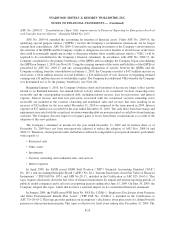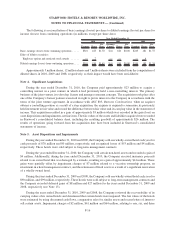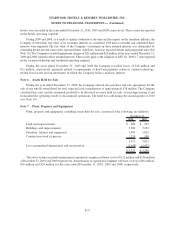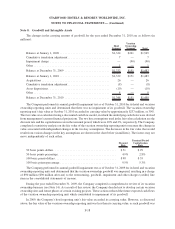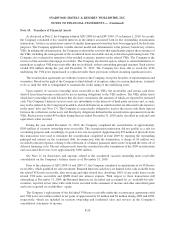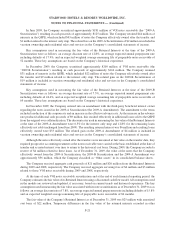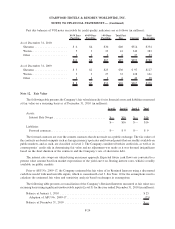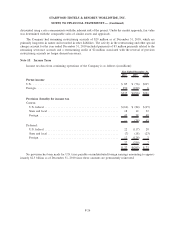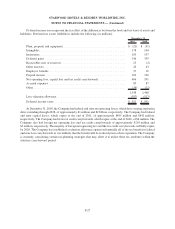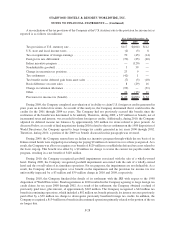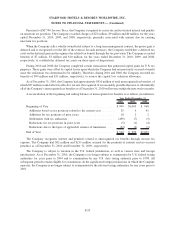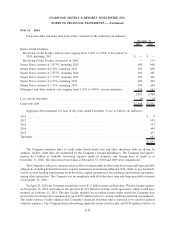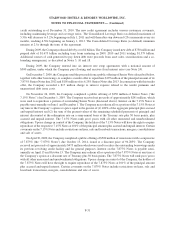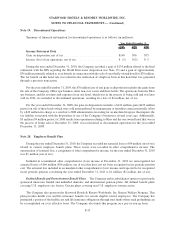Starwood 2010 Annual Report Download - page 139
Download and view the complete annual report
Please find page 139 of the 2010 Starwood annual report below. You can navigate through the pages in the report by either clicking on the pages listed below, or by using the keyword search tool below to find specific information within the annual report.
For the vacation ownership and residential segment, the Company records an estimate of expected uncollect-
ibility on its VOI notes receivable as a reduction of revenue at the time it recognizes profit on a timeshare sale. The
Company holds large amounts of homogeneous VOI notes receivable and therefore assesses uncollectibility based
on pools of receivables. In estimating loss reserves, the Company uses a technique referred to as static pool analysis,
which tracks uncollectible notes for each year’s sales over the life of the respective notes and projects an estimated
default rate that is used in the determination of its loan loss reserve requirements. As of December 31, 2010, the
average estimated default rate for the Company’s pools of receivables was 10.0%.
The activity and balances for the Company’s loan loss reserve are as follows (in millions):
Securitized Unsecuritized Total
Balance at December 31, 2007 .......................... $— $68 $ 68
Provisions for loan losses ............................ — 73 73
Write-offs ........................................ — (50) (50)
Other ........................................... — — —
Balance at December 31, 2008 .......................... — 91 91
Provisions for loan losses ............................ — 64 64
Write-Offs ....................................... — (61) (61)
Other ........................................... — — —
Balance at December 31, 2009 .......................... — 94 94
Provisions for loan losses ............................ 14 32 46
Write-Offs ....................................... — (52) (52)
Adoption of ASU No. 2009-17 ........................ 77 (4) 73
Other ........................................... (9) 9 —
Balance at December 31, 2010 .......................... $82 $79 $161
The primary credit quality indicator used by the Company to calculate the loan loss reserve for the vacation
ownership notes is the origination of the notes by brand (Sheraton, Westin, and Other) as the Company believes
there is a relationship between the default behavior of borrowers and the brand associated with the vacation
ownership property they have acquired. In addition to quantitatively calculating the loan loss reserve based on its
static pool analysis, the Company supplements the process by evaluating certain qualitative data, including the
aging of the respective receivables, current default trends by brand and origination year, and the FICO scores of the
buyers.
Given the significance of the Company’s respective pools of VOI notes receivable, a change in the projected
default rate can have a significant impact to its loan loss reserve requirements, with a 0.1% change estimated to have
an impact of approximately $3 million.
The Company considers a VOI note receivable delinquent when it is more than 30 days outstanding. All
delinquent loans are placed on nonaccrual status and the Company does not resume interest accrual until payment is
made. Upon reaching 120 days outstanding, the loan is considered to be in default and the Company commences the
repossession process. Uncollectible VOI notes receivable are charged off when title to the unit is returned to the
Company. The Company generally does not modify vacation ownership notes that become delinquent or upon
default.
F-23
STARWOOD HOTELS & RESORTS WORLDWIDE, INC.
NOTES TO FINANCIAL STATEMENTS — (Continued)



